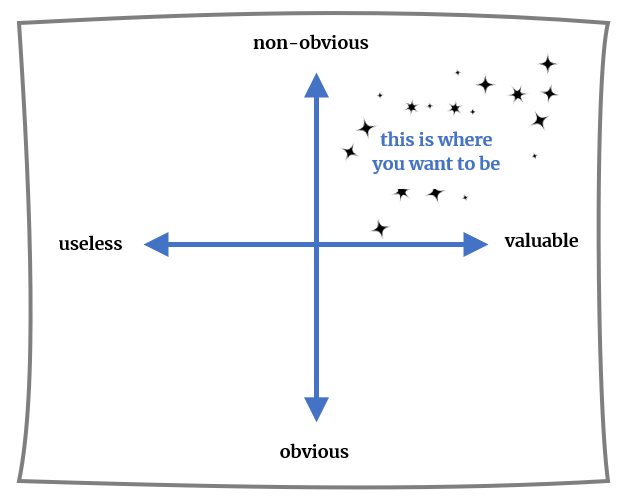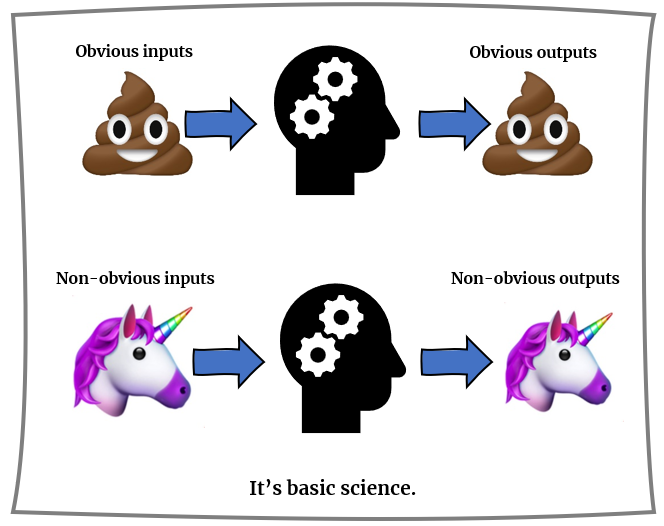Be more creative: Change your diet

Sometimes something is so simple that we miss it.
I am someone who inadvertently tends to overcomplicate things. Making something simple is not easy. Charlie Chaplin said: “Simplicity is not a simple thing.”
So, you can imagine my joy when I heard one of the fundamental principles of creativity summarised in a beautifully simple way by creativity expert, Dave Birss, in his ‘How to have fresh ideas’* course. The basic premise of this principle is: To be more creative, change your diet.
My diet? I hear you say.
Yup, but possibly not the diet you are thinking of. Let me rewind a little.
Creative thinking leaves obvious ideas behind in the dust
First, let’s clear something up. Creativity is not binary. It’s not like an idea is either creative or not. It’s not a light switch that is either on or off. It’s not as if some people are creative and some are not.
This is nonsense.
Creativity is the use of imagination to produce something that is novel and useful.
In this, widely accepted definition of creativity, novel does not need to mean Brand New. Novel does not mean Completely Original. A helpful way of thinking about ideas is obvious versus non-obvious.

An obvious idea is often the first idea that pops into your head. It’s the same idea that half the people in the room are also going to come up with. It’s taken you no extra effort to think of this idea.
Non-obvious ideas take work. They take effort, time and energy. Non-obvious ideas take stretch.
On the other axis we have useless ideas and valuable ideas. There are lots of incredible, non-obvious ideas which are absolutely useless. Those are not the ones we are after.
So which quadrant should you aim for?
The top right quadrant is your sweet spot. You want to go for non-obvious ideas that are valuable.
Most organisations play in the obvious area. We typically do the same things as everyone else. People in the same industry work in the same way. If we want to stand out and be distinctive and draw customers to us, then this is not valuable. It is more valuable to go for the non-obvious, to do things differently, to have unique selling points and ways of working.
Team brainstorms often only produce obvious ideas
Brainstorming sessions in teams often stop with mostly obvious ideas on the table.
People typically come up with the first few things that pop into their heads, add these into the pile and then move on to selecting the best ideas to work with.
Did you know, there is an actual thing called a brainstorm span? Creativity researcher and trainer, Dr Amy Climer Studies tells the story of a client of hers from Switzerland who said that her team’s brainstorms lasted for only 30 seconds before someone interjects with a criticism – even though, everyone knows you shouldn’t criticise during a brainstorm. This is a rule going back to 1948! After that first criticism, it’s hard to get back on track with generating ideas.
A brainstorm span is like an attention span. A brainstorm span is the length of time that a team is able to generate ideas before someone starts criticizing them. 30 seconds is rather sad, yet sadly this is very common. And is too short.
If the average person speaks 150 word per minute and an idea requires 15-20 words to explain, that means, at most, you can get about 8 ideas out in 30 seconds. 8 ideas is not a brainstorming session. This is more like a lazy list.
(* Refer to podcast – What is your team’s brainstorm span - )
So how do you get past the obvious?
The simple principle that helps us get past those obvious ideas to the non-obvious, creative ones is the principle of inputs and outputs.
Remember that old saying from your teachers at school? “Rubbish in, rubbish out.”
Input leads to output. If you are putting the same stuff into your head as everyone else, you are going to come up with pretty much the same ideas as everyone else. Most people have the same narrow input of pop culture going into their minds (“Kardashians and chewing gum, basically a low calorie diet for the brain, ” as Dave Birss puts it.)
To differentiate your thinking from your peers, you need to broaden your inputs. Those who watch, listen to, and experience varied and non-obvious things, are going to come up with distinctive and non-obvious ideas.

What about process? you may be asking.
Don’t some people’s brains have incredible creative capacity that can change obvious inputs into amazing, non-obvious outputs? Isn’t it actually about talent and natural creative ability?
Talent and inherent creative ability can play a small role; however, ultimately, input is the primary determinant of output. Even the world’s creative greats had to work hard and continually gather varied, new and interesting stimulation to fuel their creative fires.
Feed your mind a colourful plate
To be more creative, you need to be constantly feeding your mind a varied and interesting diet.
Just like the South African tradition of a 7 Colour Sunday lunch plate, your mental diet should involve a variety of colours, flavours and textures.

What to do now
- Review your inputs. Take note of what you are feeding your mind. What books are you reading? What podcasts are you listening to? What TV shows are you watching? What social media are you consuming? What people are you engaging with? How diverse are these inputs? Are they all related to your industry, the same few topics, one country, one age group?
- Make a list (or better yet, create a mind map) of all the topics that interest you. Go way back to your childhood and think of everything that piques your interest, that intrigues you, that you’d like to know more about.
- Plan to seek out one new input today and two more new inputs by the end of the week. An input could be as short as spending 5 minutes researching a topic on the web, to spending 90 minutes watching a documentary. It’s up to you based on how much time you are willing and able to put to this. From there, create and execute an action plan to diversify your inputs based on what is realistically achievable for you.
Why not journal what you discover. It’s been said that “we don’t learn from experience, we learn from reflecting on experience.” Take time to reflect on your journey and how your thinking changes as you take on new and interesting inputs.
I’d love to hear from you what you learn.
Cover image by Joey Guidone


